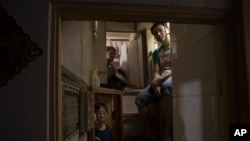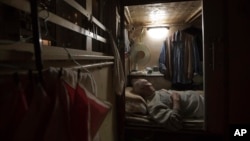Just a harbor away from a cluster of skyscrapers, in the poorest district in Hong Kong, Szeto, a resident who declined giving his full name to maintain his privacy, struggles to endure the heat inside his shoebox apartment. The heat wins.
“It’s so stuffy,” says the 47-year old. “I felt like I couldn’t breathe and had to go out.”
Szeto shares his 6-square-meter apartment with nine other people in Hong Kong’s infamous “sub-divided flats” because the territory’s rental rates are among of the highest in the world.
His life is particularly difficult this year. Hong Kong’s summer heat has been scorching, as July and September saw record-high temperatures amid the region’s most severe heatwaves since 1961.
Climatologists attribute the frequency and severity of heatwaves around the world to global warming. The United Nations says that will only increase in the decades to come.
In Hong Kong, the heatwaves have pushed residents like Szeto into a more desperate situation, according to social worker Esther Wu.
“We have did a survey [a] few months before, and we found that in cubicle in subdivided unit, the temperature is much more hotter than outside,” said Esther Wu, adding it’s “like five to six degrees hotter than outside because of the bad design of the structure of the inadequate housing.”
There are about 200,000 Hong Kongers living in subdivided flats. Many live in the cramped units because they can’t afford to rent a larger studio, and it currently takes six years on average to get a public housing apartment.
Szeto’s room has no windows, and he has to rely on his air conditioner to be able to fall asleep.
“The AC is not good enough,” says Szeto, “so even if I turn AC on the temperature [inside the room] is just as hot as outside.”
For some residents, like Chun Lai, even if they have a functioning air-conditioning unit, they can’t afford to use it.
Lai says she does not have much extra money to pay for electricity after paying the rent. She asks, “How can I afford that?”
A local NGO survey indicated about 70% of residents living in subdivided flats have found it hard to afford utility expenses, such as water and electricity, in summer.
Like Lai and Szeto, many take refuge in parks or air-conditioned shopping malls during the day.
The government has provided 18 heat shelters in different districts in the past few years to tackle urban heat. But social worker Wu says this measure hardly helps, as such shelters are only open at night.
She says officials should consider a heat subsidy from CLP (the China Light and Power utility company) for people living in poor conditions.
“Many residents reflect that it’s the hottest summer in recent years so we have to apply some subsidies from CLP,” said Wu. “It’s a subsidy at HK $1,000 … to release the burden.”
While passing a spot in the corridor where some of his roommates choose to sleep, Szeto says he’s not hopeful things will change.







